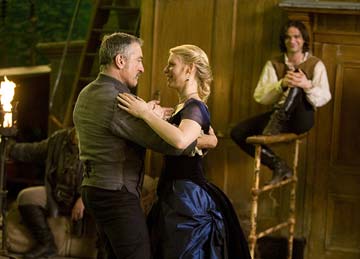 HIGH-RISE (2015); Dir. Ben Wheatley; Starring Tom Hiddleston, Sienna Miller, Luke Evans, Jeremy Irons, Elisabeth Moss; Opens Friday, May 13 at Landmark Midtown Art Cinema; Trailer here.
HIGH-RISE (2015); Dir. Ben Wheatley; Starring Tom Hiddleston, Sienna Miller, Luke Evans, Jeremy Irons, Elisabeth Moss; Opens Friday, May 13 at Landmark Midtown Art Cinema; Trailer here.
By Andrew Kemp
Contributing Writer
When the credits rolled and the lights came up on HIGH-RISE, I wasn’t sure what to think. The audience around me murmured and shifted. The film didn’t seem to go over well on them. As I left the theater, one guy asked someone (the crowd?) repeatedly “Did you like that film? Did you like that film?” In the parking lot, I overheard two women trying to make sense out of it.
So, yeah, I think I liked it.
HIGH-RISE is an intentional provocation, an agitprop object. This thing has weight, texture, depth. A century ago, people tried to burn the screen after movies like this, movies that acted as angry screeds about the increasing stratification of the classes. HIGH-RISE acts as a period piece, but couldn’t be more perfectly suited to our times. Wow, this film is mad, and it makes a solid case that we all should be madder.
Based on the 1975 J.G. Ballard novel that was long considered unfilmable, HIGH-RISE plays out like an uppercrust LORD OF THE FLIES, with an insulating luxury apartment building standing in for the far-flung desert island. Tom Hiddleston stars as Dr. Robert Laing, a desirable young doctor whose search for solitude prompts him to move to the 25th floor of the ultra-modern building that offers all the amenities of the outside world, from swimming pools to supermarkets. At first, Laing’s new environment seems like a utopian paradise full of endless parties. People from all floors mix and mingle, despite the economic divide. You see, the lower floors are for the families and the poor, and it’s these people hit the hardest when the power begins to short out. It happens a little at a time, and then all at once. The building’s architect, Royal (Jeremy Irons), offers no good explanation, and as the resources begin to dwindle, the utopia crumbles as the residents turn on one another.
 You may be asking why the residents don’t just leave the building as it stops sustaining them? This is where we approach the novel’s unfilmable reputation. Those looking for a clean narrative like LORD OF THE FLIES or even SNOWPIERCER might find themselves thrown by HIGH-RISE’s allegorical approach. The residents do leave. They go to work. Occasionally. But when the day is over, they race back to the disintegrating nightmare of their vertical world. Dogs become food. Roving bands of the well-to-do raid their neighbors for cocktail onions so that the party can continue. Laing himself becomes intent on simply finding the perfect paint color for his apartment while the bodies pile up in the pool. The allegory is that capitalism and human nature itself is the root of the evil, and it never occurs to the citizens of the block that there might be another way.
You may be asking why the residents don’t just leave the building as it stops sustaining them? This is where we approach the novel’s unfilmable reputation. Those looking for a clean narrative like LORD OF THE FLIES or even SNOWPIERCER might find themselves thrown by HIGH-RISE’s allegorical approach. The residents do leave. They go to work. Occasionally. But when the day is over, they race back to the disintegrating nightmare of their vertical world. Dogs become food. Roving bands of the well-to-do raid their neighbors for cocktail onions so that the party can continue. Laing himself becomes intent on simply finding the perfect paint color for his apartment while the bodies pile up in the pool. The allegory is that capitalism and human nature itself is the root of the evil, and it never occurs to the citizens of the block that there might be another way.
 Director Ben Wheatley has developed a reputation for off-center oddities, including 2013’s A FIELD IN ENGLAND, in which a group of men crossing a field becomes a trippy psychedelic mash. Wheatley (and his wife/writer Amy Jump) proves to be a great fit for this material, choosing to emphasize mood and meaning over the particulars of plot, which could never have come together satisfactorily without sacrificing some of the story’s deep symbolism. In this building, it’s not so easy that the rich prey on the poor, but that when the chips are down, they all prefer to eat each other. The only sane way to navigate this new world is to paint yourself into your own carved-out corner and hope to god it doesn’t come crashing through your door.
Director Ben Wheatley has developed a reputation for off-center oddities, including 2013’s A FIELD IN ENGLAND, in which a group of men crossing a field becomes a trippy psychedelic mash. Wheatley (and his wife/writer Amy Jump) proves to be a great fit for this material, choosing to emphasize mood and meaning over the particulars of plot, which could never have come together satisfactorily without sacrificing some of the story’s deep symbolism. In this building, it’s not so easy that the rich prey on the poor, but that when the chips are down, they all prefer to eat each other. The only sane way to navigate this new world is to paint yourself into your own carved-out corner and hope to god it doesn’t come crashing through your door.
Andrew Kemp is a screenwriter and game designer who started talking about movies in 1984 and got stuck that way. He can be seen around town wherever there are movies, cheap beer and little else.



